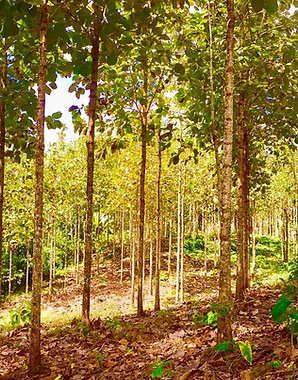
Our Forests
Our forests are the heart of our high-impact reforestation project, and we treat them accordingly. Our land-use initiatives include protected areas, which are natural forests under Nicaforest management, as well as our teak plantations located in previously degraded land. Based on the clean development mechanism, our teak forests are planted on land that had been previously deforested since 1989. This, in addition to the management of natural forests, forms the foundation of the Nicaforest project and plays a key role in fostering the health of the surrounding ecosystem.
We are proud of the work that has gone into restoring a previously depleted ecosystem, and thanks to the effort of our team & experts, we can be proud of the impact our plantations have on the environment as a whole.

Santa Elena farm
196,000 trees planted
Santa Elena is a large cattle farm that covers approximately 260 hectares and is part of two different land areas owned by the Tijerino family in the municipality of Villa Sandino.
As a family with a long history in cattle-ranging, they understand the important role reforestation plays as a part of a sustainable cattle-ranging strategy. The Nicaforest reforestation program offered a fantastic opportunity to reforest the land, and the agreement was signed in January 2012. The plantable area totaled 190 hectares, of which 100 were planted in 2012 and 90 the following year. To date, Santa Elena stands as the largest planted area in the Nicaforest portfolio, which led to the engagement of more than 60 people during the planting season alone. Today, the area is planted with approximately 150,000 certified trees, of which 50% are clones of the best genetic material, and the remaining 50% are grown from seeds.

Rosario de Fatima farm
33,000 trees planted
Rosario de Fatima is a large cattle farm that covers over 380 hectares and houses more than 200 animals. Its owners are experienced in teak growing, having part of the farm planted with teak during the mid-1980s. In 2011, approximately 30 hectares were harvested and left obsolete, which presented an opportunity to add value to the land through high-impact reforestation. For the landowners, the Nicaforest high-impact Reforestation Project became an interesting solution to re-establish the plantation in the area. Nicaforest is proud to be involved in replacing a previously obsolete teak plantation, fostering the development of a sustainable value chain around the forest

Santa Maria farm
33,000 trees planted
Santa Maria is a farm covering 86 acres (35 hectares) in the municipality of Villa Sandino. The landowner, Mr.Luna, was seeking a solution to plant trees on his property which was deforested many years ago.
During its establishment in 2013, more than 33,000 teak trees were planted as part of the reforestation effort.


Gold Standard certified high-impact reforestation
Our project holds the Gold Standard for the Global Goals certification, which plays an important role in verifying the positive impact achieved by Nicaforest. Gold Standard sets the requirements to design a project for maximum positive impact on climate and development. We believe carbon sequestration should have an impact beyond mitigating emissions and verifying that impact is key for fostering sustainable development.

The added value of sustainable land use
Our land-use initiatives include the management and protection of local forests, in addition to the reforestation of degraded land. These initiatives are integral to sustainable land use and play a key role in fostering the health of the surrounding ecosystem. By protecting native forests in addition to increasing the local biomass through the restoration of degraded land, we are able to achieve an impact that extends beyond the environment. Through fostering sustainable land use in the surrounding community, Nicaforest is able to achieve a positive impact on climate, community, and environment.

Teak
Teak (Tectona grandis) is a tropical hardwood that has long been known for its incredible durability, and today, Nicaforest leverages the high value of teak to foster a sustainable value chain around the forest and add value to the surrounding community.

